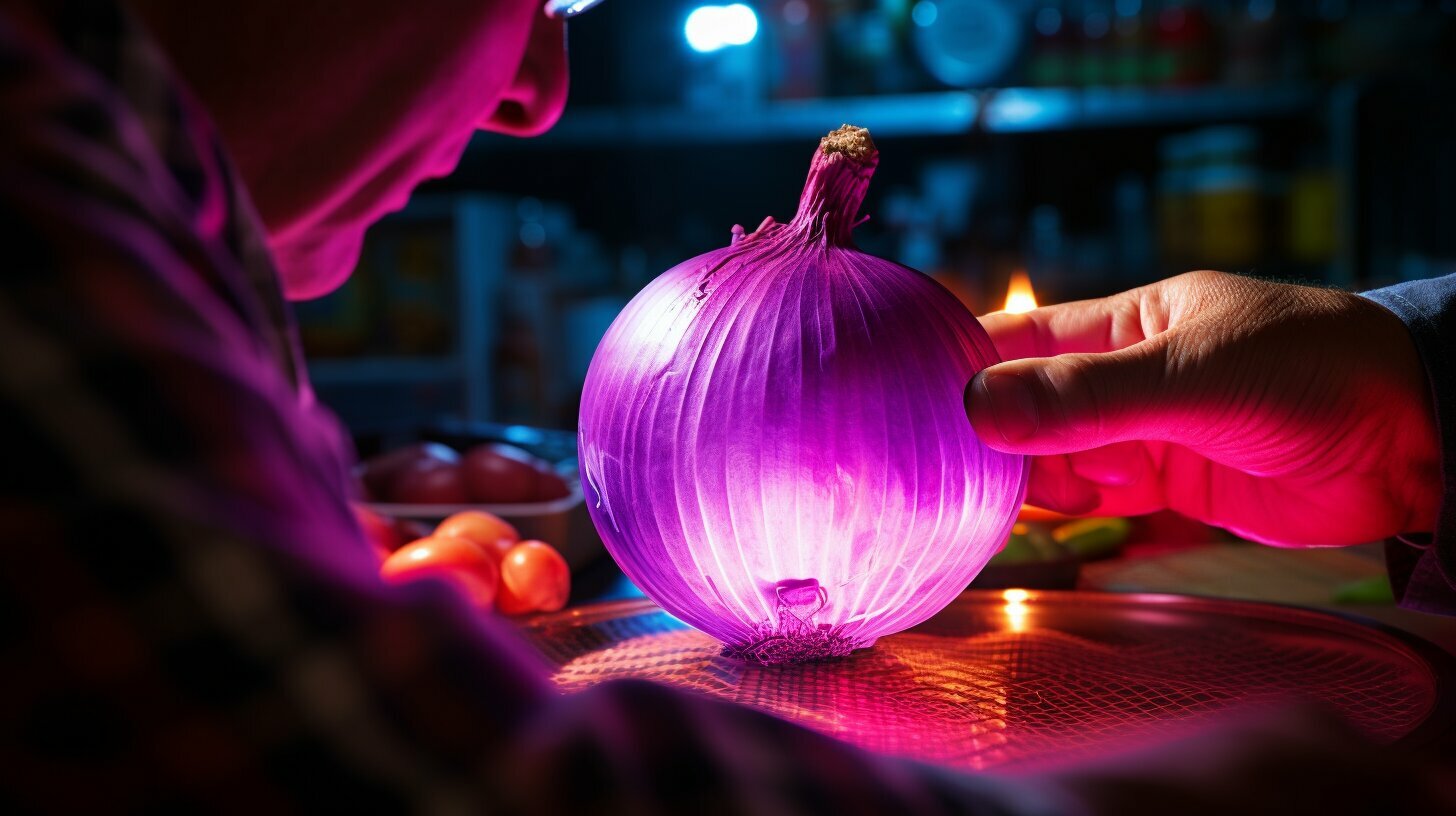Unlocking the Mystery: Why are Red Onions Purple?
Red onions are often referred to as “red” despite their purple color, but have you ever wondered why? The confusion arises from the historical classification of colors in language. Anthropologist Brent Berlin and linguist Paul Kay proposed that most languages go through different evolutionary stages when developing color terms. Red becomes a primary descriptive color in the second stage, encompassing a range of hues including purple.
The purplish color of red onions is due to the presence of compounds called anthocyanins and flavonoids, which act as antioxidants. These pigments not only give red onions their vibrant purple coloration but also provide health benefits. In fact, red onions were historically used to produce natural red dyes.
Variations in strain and growing conditions can result in red onions appearing more red or purple. Genetic variations play a role in determining the shade of purple, with some strains exhibiting a deeper red color while others showcase a more pronounced purple hue.
Key Takeaways:
- The naming of red onions as “red” despite their purple color is due to the historical evolution of color terms in language.
- Red onions derive their purple color from pigments called anthocyanins and flavonoids, which also possess antioxidant properties.
- Red onions have been historically utilized for producing natural red dyes.
- Variations in strain and growing conditions can lead to differences in the intensity and shade of purple in red onions.
- The name “red onion” is an anachronistic quirk that has persisted over time.
The Evolution of Color Terms and Red Onions
To understand why red onions are purple, we need to delve into the history of color classification and the pigments that create their vibrant hues. The confusion stems from the way colors are defined and interpreted in different languages.
Anthropologist Brent Berlin and linguist Paul Kay proposed that most languages go through different evolutionary stages when developing color terms. In the second stage, the color red becomes a primary descriptor, encompassing a range of hues, including purple. So, when we refer to red onions, the term “red” is actually a broad category that includes shades of purple.
The purplish color of red onions is due to the presence of compounds called anthocyanins and flavonoids. These pigments, which also act as antioxidants, give red onions their distinct purple hue. In fact, red onions were historically used to produce natural red dyes due to the vibrant coloring properties of these compounds.
The Role of Anthocyanins and Flavonoids
“The compounds anthocyanins and flavonoids contribute to the purple pigmentation of red onions.”
Anthocyanins are responsible for the red and purple colors in many fruits and vegetables, including red onions. These pigments are highly sensitive to changes in pH and can vary in intensity depending on the acidity or alkalinity of the environment.
Flavonoids, on the other hand, are a diverse group of plant compounds that contribute to the purple pigmentation of red onions. They work in synergy with anthocyanins to enhance the color and provide additional health benefits.
| Color Pigments | Red Onion Color |
|---|---|
| Anthocyanins | Purple |
| Flavonoids | Enhances purple color |
It’s important to note that the shade of purple in red onions can vary due to genetic variations and growing conditions. Different strains of red onions may exhibit more red or purple hues depending on their genetic makeup. Additionally, factors such as soil composition, temperature, and sunlight exposure can influence the intensity and depth of the purple coloration.
In conclusion, the name “red onion” is a historical quirk that persists despite the purple appearance of these onions. The evolution of color terms in language, as well as the presence of anthocyanins and flavonoids, explain why red onions are often referred to as “red” despite their vibrant purple color.
The Science Behind Red Onions’ Purple Color
The captivating purple color of red onions can be attributed to the presence of specific chemical compounds that create their unique pigments. These compounds, known as anthocyanins and flavonoids, are responsible for the vibrant hues exhibited by red onions.
Anthocyanins are water-soluble pigments that belong to a class of natural compounds called flavonoids. These pigments give red onions their deep, rich purple coloration. Anthocyanins are known for their antioxidant properties, which contribute to the onion’s health benefits.
Flavonoids, on the other hand, are a diverse group of plant compounds that are found in various fruits, vegetables, and herbs. They not only provide color to plants but also offer antioxidative and anti-inflammatory properties. Red onions contain specific flavonoids, such as quercetin, which work in conjunction with anthocyanins to create their purple pigmentation.
| Chemical Compounds | Color Contribution |
|---|---|
| Anthocyanins | Deep, rich purple |
| Flavonoids | Enhancement of purple pigmentation |
| Quercetin | Assists in creating purple color |
The presence of these chemical compounds in red onions not only adds to their aesthetic appeal but also provides potential health benefits. Studies have suggested that anthocyanins and flavonoids may have anti-inflammatory, anticancer, and heart-protective effects.
So, the next time you admire the beautiful purple color of a red onion, remember the scientific explanation behind it. The intriguing combination of anthocyanins and flavonoids creates a visually stunning result, making red onions a true wonder of nature.
Factors Affecting the Shade of Red Onions
The shade of purple in red onions can vary due to genetic factors and specific growing conditions. Different onion strains possess varying genetic compositions, which contribute to the range of colors observed in red onions. Some strains may produce red onions that appear more red, while others may exhibit a deeper purple hue. These genetic variations influence the types and amounts of pigments present in the onion, ultimately determining its coloration.
Additionally, growing conditions play a significant role in the development of red onion coloration. Factors such as temperature, sunlight exposure, and soil composition can impact the production and accumulation of pigments. Cooler temperatures and exposure to sunlight tend to enhance the production of anthocyanins and flavonoids, intensifying the purple pigmentation in red onions. On the other hand, warmer temperatures and reduced sunlight may result in red onions that appear more red than purple.
Varieties of Red Onions and Their Colors:
| Red Onion Variety | Color |
|---|---|
| Red Barletta | Light purple |
| Tropeana Lunga | Deep purple |
| Red Burgundy | Medium purple |
| Red Creole | Dark red with purple undertones |
The table above highlights some common red onion varieties and their corresponding colors. It exemplifies the diverse range of hues within the red onion family, showcasing how genetic factors contribute to the variation in shade and tone.
In conclusion, the shade of purple in red onions is influenced by genetic factors and specific growing conditions. The unique genetic makeup of different onion strains, along with environmental factors, determines the pigments produced and their subsequent concentration. Understanding these factors helps explain why red onions can appear anywhere from a vibrant purple to a deep red, despite their commonly used name. So, the next time you encounter a red onion, appreciate its beautiful and variable purple hues.
Conclusion
The mystery of why red onions are purple has been unraveled, shedding light on the historical, linguistic, and chemical factors that contribute to their captivating coloration. Despite being called “red” onions, their distinctive purple appearance stems from an intriguing linguistic phenomenon and the presence of specific chemical compounds.
Anthropologist Brent Berlin and linguist Paul Kay proposed that color terms in languages evolve through different stages. In the second stage, red becomes a primary descriptive color, encompassing a wide range of hues, including purple. This historical classification of colors explains why red onions, with their purple pigmentation, became known as “red” onions.
The purplish color of red onions is a result of anthocyanins and flavonoids, which are compounds with antioxidative properties. These pigments are responsible for the vibrant hues seen in various fruits and vegetables. In red onions, anthocyanins and flavonoids create a rich purple color, adding to their visual appeal.
Red onions were historically significant for their use in producing natural red dyes. Their ability to yield vibrant red pigments made them a valuable resource for various industries. Today, this historical connection to red dyes is reflected in their name, despite their striking purple appearance.
Furthermore, variations in strain and growing conditions can influence the shade and intensity of the purple color in red onions. Genetic variations and environmental factors, such as soil composition and climate, play a role in determining whether a red onion appears more red or displays a deeper purple hue.
In conclusion, the captivating coloration of red onions combines historical, linguistic, and chemical factors. From the evolution of color terms in language to the presence of anthocyanins and flavonoids, red onions continue to intrigue us with their vibrant, purple allure. So, the next time you come across a red onion, remember the fascinating story behind its striking hue!
FAQ
Why are red onions purple?
Red onions are often referred to as “red” despite their purple color. The confusion arises from the historical classification of colors in language.
What causes the purplish color in red onions?
The purplish color of red onions is due to the presence of compounds called anthocyanins and flavonoids, which act as antioxidants.
Were red onions historically used to produce red dyes?
Yes, red onions were historically used to produce natural red dyes due to their vibrant purple pigmentation.
Why do red onions sometimes appear more red or purple?
Variations in strain and growing conditions can result in red onions appearing more red or purple.
Why are red onions still called “red” if they are purple?
The name “red onion” is an anachronistic quirk that has persisted over time, despite the purple color of these onions.






